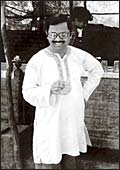 |
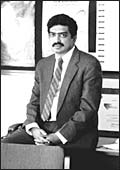 |
| Who's that?: Murthy at a
1980s-picnic (left) and Nilekani |
On
July 2, 2006, Infosys technologies will turn 25. That's not a
significant age for a company; several Indian companies are older.
In these 25 years, however, Infosys has set new standards in governance
and wealth creation (both for employee and shareholders) and turned
an entire industry on its head (global delivery as opposed to
offshoring). Despite the rash of publicity the company receives,
however, there are still things about it that are little-known.
Here are 25 such.
1.
Infosys wasn't N.R. Narayana murthy's first entrepreneurial venture.
That would have to be a company called Softronics, an IT consulting
firm that Murthy founded in Pune in 1976. He wound it up (when
he realised that focusing on the domestic market wouldn't take
the firm anywhere) and signed up to head Patni's software business.
2.
Murthy is employee # 4, not employee number # 1 at Infosys. Although
he resigned on December 29, 1980, the day he decided to start
Infosys, Murthy did not join Infosys, which was incorporated on
July 2, 1981, until 18, March 1982. He had promised Ashok Patni
that he would complete two projects and it took him that long
to do that. "I must have served the longest notice period
in the history of corporate India," laughs Murthy. P.S: N.S.
Raghavan was employee # 1
P.P.S: Infosys doesn't repeat employee numbers; today, the number
for fresh employees in the software business is well into the
60,000s.
3.
Nandan Nilekani decided to become an entrepreneur a few days before
his marriage. Nilekani was to get married in the first week of
January, 1981. In late December 1980, when Murthy and Raghavan
told him of their plan to quit and start a company he cast in
his lot with them.
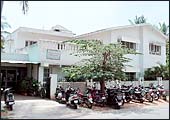 |
| Where's that: This Jayanahar
house was once Infy's office |
4.4.
Infosys has seven founders, not six. The names of the six are
well known: apart from the three mentioned above, S. 'Kris' Gopalakrishnan,
S.D. Shibulal, and K. Dinesh. The seventh was Ashok Arora. However,
he left in 1989, in what would later become the company's first
major 'point of inflection'.
5.
Infosys didn't have a computer in its first two years of existence.
Even as the company waited for permission to import a computer
it started operations as a body shopper in the true sense of the
word. The computer came later, and the global delivery model much
later, although, documents show that the company had started speaking
of this trend as way back as in 1993.
6.
Murthy was (and could well be) one of the best software engineers
ever produced by India. At least two of Infosys' early recruits-both
have left the company now; one runs a software products firm,
and the other is a consultant- speak highly of Murthy's technical
capabilities, something that is all but forgotten today by most
people. "As long as computers continue to be based on the
Von Neumann architecture," says D.N. Prahlad, Founder and
Managing Director, Surya Software Systems, and a former Infosys
employee (he left in mid-1998 when he was heading one of the company's
business units), "Murthy will probably be on top of systems
and software."
 |
| Three founders: (from left)
Dinesh, Raghavan, and Arora |
7.
Sharad Hegde was Infosys' first non-founder employee. A former
Patni employee, Hegde was Infosys' tech-guru in its early years.
He left the company only in the early 2000s and is currently working
on setting up a golf resort near Bangalore. His wife, Anu, who
left the company in the early 1990s, was an expert in quality
and processes. The two met in Infosys and were Infosys' first
'office romance'.
8.
Infosys' early recipe for success would now be considered a radical
innovation in the software industry: zero-defect code. Murthy,
one early employee recalls, was obsessed with zero-defect code.
Even today, the accepted way to code is to write software, then
debug it. Murthy would have none of that. In the company's early
years, Murthy and Dinesh and Shibulal and Kris taught recruits
how to write code without errors.
9.
One of Infosys' early go-to-market vehicles was a joint venture
with ksa, ksa-Infosys. And Kris, who spent much of the 1980s in
the us, was Infosys' face in the jv. The joint venture collapsed
in 1989.
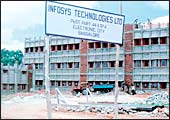 |
| Heritage space: This building,
now called Heritage Building, was the first to come up on
the campus |
10.
Infosys almost wound up in 1989. "Our peers had cars and
houses," recalls Kris referring to one reason for what he
calls "a major introspection" that happened in 1989.
"And we had nothing." "The JV with KSA collapsed
in that year," remembers Dinesh. Arora, too, decided to leave
that year. Murthy asked his co-founders whether they wanted out.
They did. He offered to buy them out. "At which point,"
says Dinesh, we said, 'We thought you wanted out too'." They
decided to stick it out.
11.
Most people attribute Infosys' success to its superior planning
process. Well, this started in 1989. "It wasn't anywhere
near as sophisticated as what we do now," says Nandan, "but
it started then." The first plan gave the founders who had
just come off a gut-wrenching discussion on whether to wind up
or not, several immediate objectives. The first was the decision
to build a campus (... "and spend more on it than our turnover
then," says Murthy). The second was the decision to make
an initial public offering.
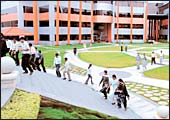 |
| Future city: The same Electronics
City now houses several dozen other buildings, like the one
shown here |
12.
Manmohan Singh facilitated Infosys' IPO. Infosys wanted to issue
its shares at a premium. Until the early 1990s, issue-pricing
was decided by the Controller of Capital Issues. The CCI decided
that Infosys could make an issue at a premium of Re 1 (issue price:
Rs 11). The company demurred. Then, Singh abolished the post of
CCI in the first wave of economic reforms and Infosys went ahead
with an issue (in February 1993) at a premium of Rs 86 (issue
price: Rs 96).
13.
The market may love Infosys today, but most brokers thought the
company was just another fly-by-night operator in the 1990s. A
consultant involved in the IPO remembers that when he spoke to
a few brokers in Mumbai about the issue, the unanimous response
was that since an unknown company was trying to make an IPO at
a premium "its promoters were certain to be thieves."
"I knew things had changed when a few months after the issue,
one of those same brokers called me up and asked whether I could
arrange a meeting for him with the promoters."
14.
Infosys' promoters are rich today because of a decision they took
early in the company's existence. "We decided that we would
pay dividends from day one, pay taxes on the dividend we received,
and re-invest the entire sum as equity in the business,"
says Murthy.
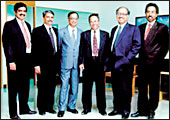 |
| Foundation series: (Above,
from left), Nilekani, Kris, Murthy, Raghavan, Dinesh, and
Shibu; (Left), Kumari Shibulal, Rohini Nilekani and Sudha
Murthy |
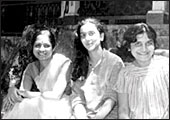 |
15.
The Infosys IPO almost devolved. Murthy claims that the issue
was subscribed 1.06 times, and it was, but fact is, it almost
didn't go through. Eventually Vallabh Bhansali's Enam Financial
Consultants, the lead manager (along with SBI Capital Markets),
had to push it through.
16.
Nilekani's quiz-club members struck it rich. Well, some of them
did. Nilekani was a quizzer in college and was part of an informal
group that would meet and quiz in Bangalore. One member remembers
that Nilekani came to a meeting with a battered attaché
case, pulled out some IPO forms, and tried to interest them in
the offering. "I did invest in Infosys," says the man,
"and never had cause to regret it." Nilekani also remembers
visiting some of his IIT batchmates working in Mumbai "with
the same battered attaché case" and trying to interest
them in some shares.
17.
If there's a photographic history of the early years of Infosys,
Shibulal is the man to thank for that. "I was always interested
in photography," says Shibulal, Director and Head, Worldwide
Customer Sales & Delivery, "and in collecting photographs."
For some time in the 1990s, Shibu, as he is known within the company,
left Infosys to work for Sun Microsystems in the US. The official
version is that he did that to acquire some perspective on how
a large technology company works and that it was always clear
that he would return to Infosys.
18.
Nilekani may be CEO today and Kris coo, but the latter was actually
senior to the former at one point in time. Nilekani, most Infoscions
and Exfoscions agree, was always the big-picture man at the company.
"It was Kris himself who suggested in the 1990s that Nandan
could be given a larger role and that he wouldn't have a problem
with it," says Murthy.
19.
The real reason for the GE-business falling through in 1994: Murthy
wanted the Indian software industry to stick to its guns; it didn't.
In 1994, Infosys said it would no longer be doing work for GE,
thereby closing the door on a business that then accounted for
almost a third of its revenues. The reason had to do with GE's
decision to ask for a reduction in billing rates. Murthy met with
the heads of the other major Indian software firms then working
for GE and suggested that if they all refused to work on the lower
rate, the company would have no option but to give them a fair
deal. The CEO of one company didn't agree and Infosys ended up
being the only company to opt out of doing business for GE.
|
|
| Empire builders: (Right)
a recent picture of Murthy and Nilekani; the campus (below) |
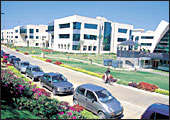 |
20.
Infosys has reason to remember Nordstrom fondly: the retailer
agreed to what was then a record billing-rate. The first major
customer Infosys signed on after refusing the GE business was
Nordstrom, and at a far higher billing-rate. Not surprisingly,
one of Nordstrom's senior executives was a honoured guest when
Infosys showcased its Electronics City campus to the world in
1994. One individual present on the occasion remembers that the
CEO of a large rival software firm based in Bangalore and his
deputy were keen to meet with the man, but that Phaneesh Murthy,
the man who had signed the deal for Infosys, kept them at bay.
21.
Mohandas Pai works for Infosys because he asked difficult questions
at a shareholder meeting. Give me any annual report and I can
analyse it threadbare in minutes," says Pai, who, at the
time he posed the questions, was working at Prakash Leasing, Bangalore.
Murthy and Nilekani decided that Pai would be a good resource;
he signed on as a consultant initially. P.S: Pai has been reading
annual reports since the age of 15.
22.
Most people in Infosys saw Phaneesh as Murthy's successor in the
late 1990s and the early 2000s. Murthy, most Infoscions (as employees
are known; former employees are called Exfoscions) admit, was
inordinately fond of Pai and Phaneesh simply because he thought
their performance extraordinary. Given Phaneesh's age (he is now
44) and his profile (he was head of sales and was responsible
for helping the company grow from a $10 million one to a $700
million one between 1992 and 2002) most people within the company
saw him as Murthy's successor. Then, the sexual harassment suit
(circa 2002, when a former Infosys employee in the us, Reka Maximovitch,
alleged that she had been harassed by Phaneesh) happened, and
Phaneesh had to leave the company.
23.
Infosys picked Nations Banc Montgomery Securities as lead manager
for its 1999 NASDAQ listing because ... The firm, one individual
in the know claims, was the only one of around 10 i-banks that
pitched for the business to acknowledge that the company's services-play
was a good thing. All the others harped on the importance of products.
24.
Surprise: Infosys itself thought it would have to necessarily
have a product play. For much of the 1990s Infosys projected that
between 30 per cent and 40 per cent of its revenues would come
from products.
25.
The NASDAQ issue almost didn't happen. Everyone was working hard
in the run-up to Infosys' IPO on nasdaq and two departments (one
of which was Pai's finance) squabbled over something. Murthy was
willing to call off the issue if it meant this would be the impact
of growth and success on the company's culture. Pai admits that
"... around the time of the IPO, there was an event where
Murthy had to choose between me and the company and he chose the
company."
|













